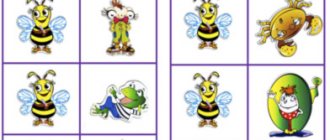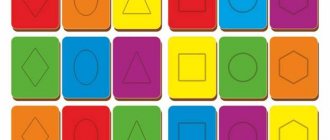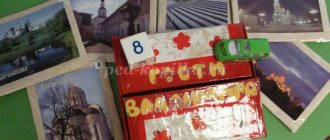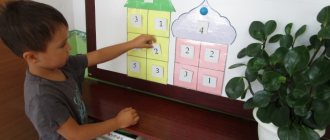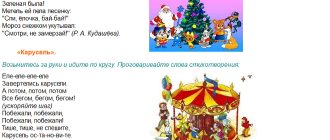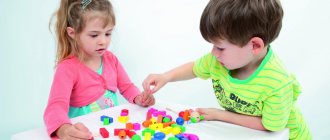Collection of didactic games
"Cars"
There are long and short strips of the same width on the table
The teacher invites the children to take one strip each. These are the “numbers” of the cars. And the gates are garages. Let the guys imagine that they are all “cars”, each with their own “number”. "Cars" will drive around the city. But as soon as the presenter says: “Cars, go to the garage!” - everyone must find their own garage and move into it. To do this, you need to attach the “number” of your car to the “number” on the gate. If the “numbers” are the same in length, you can move in.
During the game “Cars”, show the children an illustration. Ask them questions to help them make sense of what is happening.
The game is repeated 2 times.
"Merry dolls"
Purpose of the game: to teach to distinguish and compare objects according to different qualities of quantities.
Equipment: 2 sets of five-seater nesting dolls, 2 sets of circles of different sizes, a tower made of hollow cubes.
Progress of the game: At the invitation of the teacher, the children sit at a common table on which there is a nesting doll. The teacher turns to the children: “I want to play funny nesting dolls with you, but I see that there is only one nesting doll here, but where are the rest? (looks around, and then picks up a matryoshka doll and shakes it). Something is rattling in the middle! Let's see what's there? (Removes the upper half of the matryoshka doll). This turns out to be where they hid! (All nesting dolls are placed in a row). Let's get to know them! The teacher calls the name of each doll, tilting it: “I am Matryosha, I am Natasha, I am Dasha, I am Masha,” etc. Each child chooses one of the nesting dolls (the teacher takes one matryoshka for himself). The game begins. First, the nesting dolls walk (walk on the table). Then they are called to measure height. They line up one after another and take turns, starting with the smallest one, standing according to height, and the teacher clarifies which nesting doll is the smallest (tallest)? Then the nesting dolls go to dinner. The teacher puts on the table a set of circles (plates) of five sizes, calls the children in turn, who select plates of the appropriate size for their nesting dolls. After lunch, the nesting dolls get ready for a walk. The teacher puts the second set of nesting dolls on the table, and the children select girlfriends of the same height for their nesting dolls. Pairs of nesting dolls move around the table. Then they run away and mingle. (“The nesting dolls wanted to run”). Unnoticed by the children, the teacher removes a pair of nesting dolls of the same height from the table. "Time to go home! - says the teacher. Get into pairs." The nesting dolls are lined up in pairs, and suddenly it turns out that a certain pair of nesting dolls is missing. The teacher invites the children to call the nesting dolls by name (if they remember). Everyone asks her to come back in unison. The nesting dolls appear, the kids put them in place and the toys go home. The teacher places on the table a tower made of hollow cubes (one side is missing) - these are houses for nesting dolls. At the request of the teacher, each child finds a home for his nesting doll. The nesting dolls bow, say goodbye and go home.
Games of magnitude for older children.
Games of magnitude for older children.
"Three squares"
Target:
teach children to correlate three objects by size and indicate their relationships with the words: “big”, small”, “medium”, largest”, “smallest”.
Equipment.
Three squares of different sizes, flannelgraph; Children have 3 squares, flannel.
Teacher:
Children, I have 3 squares, like these (shows). This one is the biggest, this one is smaller, and this one is the smallest (each of them shows). Now show the largest squares (children pick them up and show them), put them down. Now raise the averages. Now - the smallest ones. Next, V. invites the children to build towers from the squares. Shows how this is done: places on the flannelgraph from bottom to top, first a large, then a medium, then a small square. “Make such a tower on your flannelographs,” says V.
"Three Bears"
Target:
practice comparing and ordering objects by size.
Equipment.
V. has silhouettes of three bears, children have sets of toys in three sizes: tables, chairs, beds, cups, spoons.
The teacher gives the children a set of objects of the same type: three spoons of different sizes, three chairs, and so on. He says: “Once upon a time there were three bears. What were their names? (Children call). Who is this? (Puts the silhouette of Mikhail Ivanovich). What size is it? And who is this? (Nastasya Petrovna). Is she bigger or smaller than Mikhail Ivanovich? What kind of Mishutka? (Small). Let's give each bear a room. The biggest bear, Mikhail Ivanovich, will live here. Which one of you has a bed, chair, etc. for Mikhail Ivanovich? (Children place objects near the bear; in case of a mistake, Mikhail Ivanovich says: “No, this is not my bed”). Do you have a bed, chair, etc. for Mishutka? (The children arrange a room for him.) Who were these items left for? (For Nastasya Petrovna). What size are they? (Less than for Mikhail Ivanovich, but more than for Mishutka). Let's take them to Nastasya Petrovna. The bears set up their home and went for a walk in the forest. Who's going ahead? Who's behind him? Who is last? (The teacher helps the children remember the relevant fragments of the fairy tale).
"Beautiful pattern"
Target:
learn to select quantities based on the word-name of objects, develop attention; form a positive attitude towards the result obtained - the rhythmic alternation of values.
Equipment.
Strips of clean thick paper according to the number of children, geometric shapes of different sizes for laying out patterns (circles, squares, rhombuses, hexagons, etc.); trays, typesetting cloth.
Guide Methodology:
The teacher hands out sheets of paper to the children and places trays with geometric shapes on the table. He says that now they will lay out a beautiful pattern, shows a sample of the action: “Big square. (Takes the form and inserts it into the typesetting canvas). A small square, another small square." (Inserts it back into the canvas, etc.) then the teacher suggests laying out the forms under dictation. At the beginning, he makes sure not only that the values are correctly alternating, but also that the children act from left to right and maintain the same distance between elements. When the task is repeated, other forms are given, and their alternation also changes. In conclusion, the teacher examines the resulting patterns and gives all works a positive assessment.
"Hedgehog"
Target:
learn to correlate objects by size, to identify size as a significant feature that determines actions; consolidate the meaning of the words “big”, “small”, “more”, “less”, introduce them into the children’s active vocabulary.
Equipment.
Cardboard stencils depicting hedgehogs and umbrellas of four sizes.
Guide Methodology:
The teacher says that now he will tell a fairy tale about hedgehogs: “A family of hedgehogs lived in the forest: dad, mom and two hedgehogs. One day the hedgehogs went for a walk and went out into the field. There was neither a house nor a tree there (Invites the children to find hedgehog figures on trays and put them in front of them. He approaches each one and places the figures in a row according to size). Suddenly daddy the hedgehog said: “Look how big the cloud is. It's going to rain now." “Let’s run into the forest,” suggested the hedgehog’s mother. “Let’s hide under the tree.” But then it started to rain, and the hedgehogs did not have time to hide. You guys have umbrellas. Help the hedgehogs, give them umbrellas. Just look carefully at which umbrella is suitable for whom. (See if children use the principle of comparing objects by size.) “Well done, now all the hedgehogs are hiding under umbrellas. And they thank you." The teacher asks someone why he gave one umbrella to daddy the hedgehog and another to mommy hedgehog; next child - why did he give the little hedgehogs different umbrellas? Children answer, and the teacher helps them formulate the answer correctly.
"Let's build houses"
Target:
learn to visually correlate the size of objects and check your choice by superimposing; develop attention; consolidate words that define the relativity of quantities “more”, “less”, “same”.
Equipment.
1st option. Three cardboard houses of different sizes with slots for doors and windows, without roofs; cardboard windows, doors, roofs of three sizes, corresponding to the size of the houses. 2nd option. Small cardboard houses without roofs with slots for windows and doors, elements for them (roofs, doors, windows) for each child.
Guide Methodology:
The teacher inserts large images of three houses into the typesetting canvas, placing them in random order and not in a row. The elements of houses (roofs, windows, doors) are mixed up on the table. Then he tells the children that they will be builders, they will complete houses, which should be neat and level; All parts should be selected so that they fit the required parts. The children go around and take turns “finishing” the houses. Those sitting at the table take part in the assessment of each stage of the work. At the end, the teacher sums it up: “We installed smaller doors, a smaller roof, and smaller windows for the largest house. And the smallest house has the smallest windows, the smallest door, the smallest roof.”
"Long - short"
Target:
development in children of a clear differentiated perception of new qualities of size.
Equipment.
Satin and nylon ribbons of different colors and sizes, cardboard strips, story toys: a fat bear and a thin doll.
Guide Methodology:
Before starting the game, V. lays out sets of gaming didactic material (multi-colored ribbons, stripes) on two tables in advance. The teacher takes out two toys - a teddy bear and a Katya doll. He tells the children that Misha and Katya want to be dressed up today, and for this they need belts. He calls two children and gives them ribbons rolled into a tube: one short - a belt for Katya, the other long - a belt for a bear. Children, with the help of V., try on and tie belts for toys. The toys express joy and bow. But then the toys want to change belts. The teacher suggests taking off the belts and changing their toys. Suddenly he discovers that the doll’s belt doesn’t fit on the bear, and the belt is too big for the doll. The teacher offers to examine the belts and spreads them side by side on the table, and then places a short ribbon on a long one. He explains which ribbon is long and which is short, i.e. he gives the name for the quality of quantity - length. After this, V. shows the children two cardboard strips - a long one and a short one. Shows children how to compare strips with ribbons by overlapping them and tell which one is short and which one is long.
Fragments of a lesson on the topic “Magnitude” in the senior group.
- Fragment
Guys, look at the mess in the forest. The Christmas trees grow randomly, even the paths are not visible. Where to go? Let's plant the Christmas trees in descending order, starting from the tallest to the shortest. After we plant the Christmas trees, we will count them. What do you think you can say about the height of Christmas trees? Children's answers: The Christmas trees are planted in descending order.
Now, I propose to plant the Christmas trees starting from the lowest and ending with the highest. After we plant, we will count the Christmas trees. What do you think you can say about the height of Christmas trees? Children's answers: The Christmas trees are planted in ascending order.
- Fragment
Guys usually come to visit with gifts. I suggest giving ribbons to the animals. Take the ribbons and arrange them in descending order from longest to shortest. Name the length of each ribbon. Now arrange the ribbons in ascending order, starting with the shortest and ending with the longest. Now name the length of each ribbon. What can you say about the length of the adjacent ribbons: blue and yellow? Children's answers: The yellow ribbon is longer.
What can you say about the length of the blue ribbon compared to the pink one?
Children's answer: The blue ribbon is longer than the pink one.
Well done. Put the ribbons on a tray, we will give them to the animals.
3. Fragment
1. Working with demonstration material. "Tracks"
— The fox and the crane became friends. After a quarrel, the crane moved away from the fox to another place so that the fox would not find him. But the fox wanted to make friends with him again and went to look for him. She walked and saw high and low houses, to which wide and narrow paths led. The fox wanted to follow the narrowest path, but does not know which of them is the narrowest. Let's help the fox.
2. Work with handouts.
- Count your tracks, (call the 1st child to the board)
— Lay out the paths from top to bottom from widest to narrowest.
— Let’s tell you what the width of the tracks is.
- Which path will the fox take? (Children's answers).
3. “Houses” - working with demonstration material.
The fox walked along the narrowest path and reached the houses.
- Count the houses.
- Let's arrange the houses from lowest to highest.
—Name them by height
- What house do you think the crane lives in? (Children's answers).
- And now we will put a crane on each house. The height of the crane must coincide with the height of the house (checked by the child).
— The crane lives in the biggest house.
The fox found the crane's house.
4. “Nuts” - work with handouts.
— The fox brought nuts to the crane as a gift, but scattered them in front of the house. Let's help the fox collect them. Girls collect in one basket, and boys in another. Let's count the nuts from the smallest to the largest and arrange them from left to right. Name their size. The fox gave all the collected nuts to the crane, he was happy and gave her tea. Lisa also invited him to visit her.
Exercise games on the theme of geometric shapes and shapes.
"Pick a figure"
Target:
consolidate the ability to distinguish geometric shapes: rectangle, triangle, square, circle, oval.
Material: each child has cards on which a rectangle, square and triangle are drawn, the color and shape vary.
Content:
First, the teacher suggests tracing with your finger the figures drawn on the cards. Then he presents a table on which the same figures are drawn, but of a different color and size than the children’s, and, pointing to one of the figures, says: “I have a big yellow triangle, what about you?” Etc. Calls 2-3 children, asks them to name the color and size (large, small of their figure of this type). “I have a small blue square.”
"Gather a figure"
Target:
learn to count objects that form a figure.
Content:
The teacher invites the children to move a plate with chopsticks towards them and asks: “What color are the chopsticks? How many sticks of each color? He suggests arranging sticks of each color so that different shapes are obtained. After completing the task, the children count the sticks again. Find out how many sticks went into each figure. The teacher draws attention to the fact that the sticks are arranged differently, but there are equal numbers of them - 4 “How to prove that there are equal numbers of sticks? Children lay out the sticks in rows, one below the other.
“Why doesn’t the oval roll?”
Target:
introduce children to an oval shape, teach them to distinguish between a circle and an oval shape
Content:
Models of geometric shapes are placed on the flannelgraph: circle, square, rectangle, triangle. First, one child, called to the flannelograph, names the figures, and then all the children do this together. The child is asked to show the circle. Question: “What is the difference between a circle and other figures?” The child traces the circle with his finger and tries to roll it. The teacher summarizes the children’s answers: a circle has no corners, but the rest of the figures have corners. 2 circles and 2 oval shapes of different colors and sizes are placed on the flannelgraph. “Look at these figures. Are there any circles among them? One of the children is asked to show the circles. Children's attention is drawn to the fact that there are not only circles on the flannelgraph, but also other figures. , similar to a circle. This is an oval-shaped figure. The teacher teaches to distinguish them from circles; asks: “How are oval shapes similar to circles? (Oval shapes also have no corners.) The child is asked to show a circle, an oval shape. It turns out that the circle is rolling, but the oval-shaped figure is not. (Why?) Then they find out how the oval-shaped figure differs from the circle? (the oval shape is elongated). Compare by applying and superimposing a circle on an oval.
“Who will find it faster?”
Target:
practice matching objects by shape with geometric patterns and generalizing objects by shape.
Content:
Children are invited to sit at tables. One child is asked to name the figures standing on the stand. The teacher says: “Now we will play the game “Who can find it faster.” I will call one person at a time and tell them what object needs to be found. The first one to find the object and place it next to a figure of the same shape wins.” Calls 4 children at once. Children name the selected object and describe its shape. The teacher asks questions: “How did you guess that the mirror is round? Oval? etc.
In conclusion, he asks questions: What is next to the circle? (square, etc.). How many items are there in total? What shape are these objects? How are they all similar? How many are there?
"Unfinished Pictures"
Target:
introduce children to the varieties of geometric shapes of rounded shapes.
Material. For each child, a piece of paper with unfinished images (1-10 items). To complete them, you need to select round or oval elements. (1-10) paper circles and ovals of appropriate sizes and proportions. Glue, brush, cloth.
Content:
The teacher invites the children to find out what is shown in the pictures. When everyone figures this out together, he offers to pick up the figures missing in the drawings and stick them on. Before gluing, checks the correct selection of shapes. Completed works are exhibited, and children themselves find each other’s mistakes.
"Room Tour"
Target:
learn to find objects of different shapes.
Content:
Children are shown a picture of a room with various objects. The teacher begins the story: “One day Carlson flew to the boy: “Oh, what a beautiful room,” he exclaimed. - There are so many interesting things here! I've never seen anything like this." “Let me show you everything and tell you,” the boy answered and led Carlson around the room. “This is the table,” he began. “What shape is it?” - Carlson immediately asked. Then the boy began to tell everything about every thing in great detail. Now try, just like that boy, tell Carlson everything about this room and the objects that are in it.
Games on the theme “space” in the preparatory group.
"Controller"
Goal: to consolidate spatial orientation skills in the process of correlation
children of paired opposite directions of their own body with the directions of the person standing opposite.
Equipment: red and green tickets, hoops
Contents: the child (controller) is located in front of other participants in the game - passengers who have red and green tickets. Behind the “controller” on the right and left sides are placed hoops indicating buses. “Passengers” with red tickets are directed by the “controller” to the left bus, and with green tickets to the right one.

